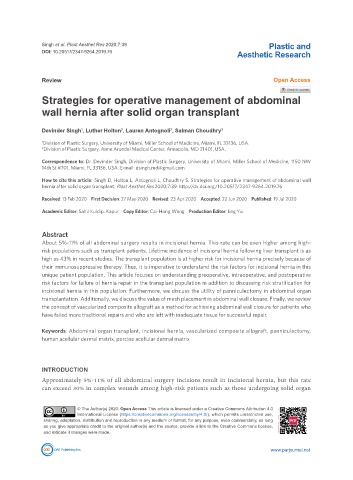Page 419 - Read Online
P. 419
Singh et al. Plast Aesthet Res 2020;7:39 Plastic and
DOI: 10.20517/2347-9264.2019.76 Aesthetic Research
Review Open Access
Strategies for operative management of abdominal
wall hernia after solid organ transplant
Devinder Singh , Luther Holton , Lauren Antognoli , Salman Choudhry 2
1
2
2
1 Division of Plastic Surgery, University of Miami, Miller School of Medicine, Miami, FL 33136, USA.
2 Division of Plastic Surgery, Anne Arundel Medical Center, Annapolis, MD 21401, USA.
Correspondence to: Dr. Devinder Singh, Division of Plastic Surgery, University of Miami, Miller School of Medicine, 1150 NW
14th St #701, Miami, FL 33136, USA. E-mail: dsingh.md@gmail.com
How to cite this article: Singh D, Holton L, Antognoli L, Choudhry S. Strategies for operative management of abdominal wall
hernia after solid organ transplant. Plast Aesthet Res 2020;7:39. http://dx.doi.org/10.20517/2347-9264.2019.76
Received: 13 Feb 2020 First Decision: 27 May 2020 Revised: 23 Apr 2020 Accepted: 22 Jun 2020 Published: 19 Jul 2020
Academic Editor: Sahil Kuldip. Kapur Copy Editor: Cai-Hong Wang Production Editor: Jing Yu
Abstract
About 5%-11% of all abdominal surgery results in incisional hernia. This rate can be even higher among high-
risk populations such as transplant patients. Lifetime incidence of incisional hernia following liver transplant is as
high as 43% in recent studies. The transplant population is at higher risk for incisional hernia precisely because of
their immunosuppressive therapy. Thus, it is imperative to understand the risk factors for incisional hernia in this
unique patient population. This article focuses on understanding preoperative, intraoperative, and postoperative
risk factors for failure of hernia repair in the transplant population in addition to discussing risk stratification for
incisional hernia in this population. Furthermore, we discuss the utility of panniculectomy in abdominal organ
transplantation. Additionally, we discuss the value of mesh placement in abdominal wall closure. Finally, we review
the concept of vascularized composite allograft as a method for achieving abdominal wall closure for patients who
have failed more traditional repairs and who are left with inadequate tissue for successful repair.
Keywords: Abdominal organ transplant, incisional hernia, vascularized composite allograft, panniculectomy,
human acellular dermal matrix, porcine acellular dermal matrix
INTRODUCTION
Approximately 5%-11% of all abdominal surgery incisions result in incisional hernia, but this rate
can exceed 30% in complex wounds among high-risk patients such as those undergoing solid organ
© The Author(s) 2020. Open Access This article is licensed under a Creative Commons Attribution 4.0
International License (https://creativecommons.org/licenses/by/4.0/), which permits unrestricted use,
sharing, adaptation, distribution and reproduction in any medium or format, for any purpose, even commercially, as long
as you give appropriate credit to the original author(s) and the source, provide a link to the Creative Commons license,
and indicate if changes were made.
www.parjournal.net

